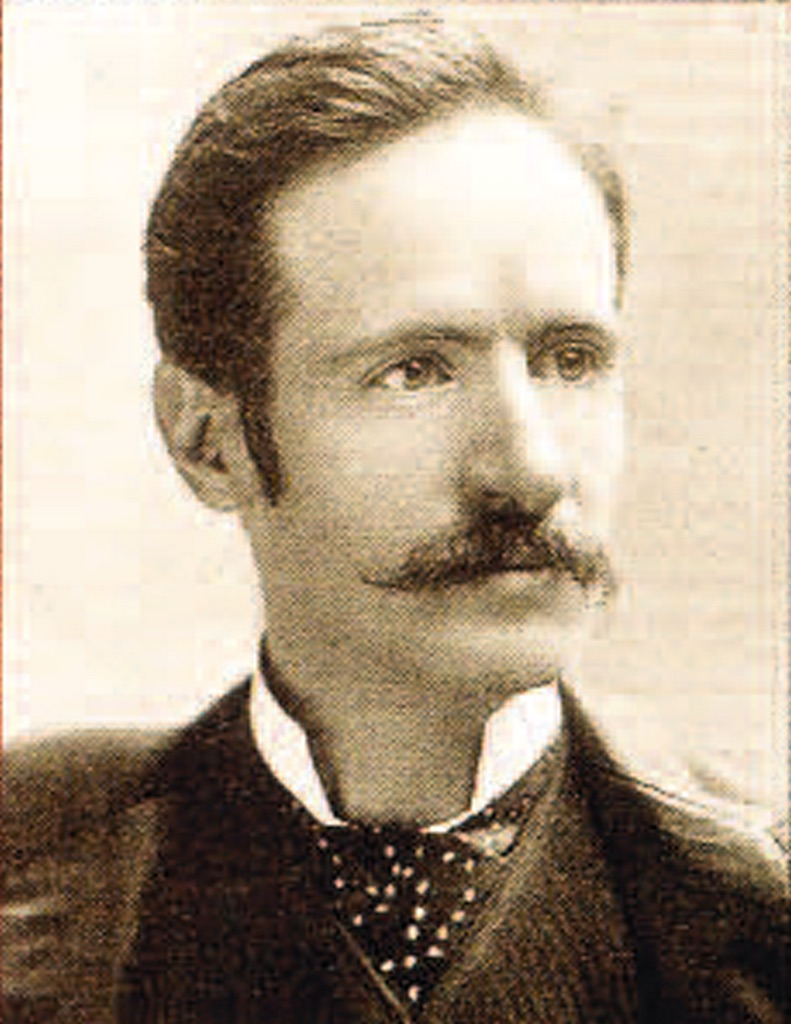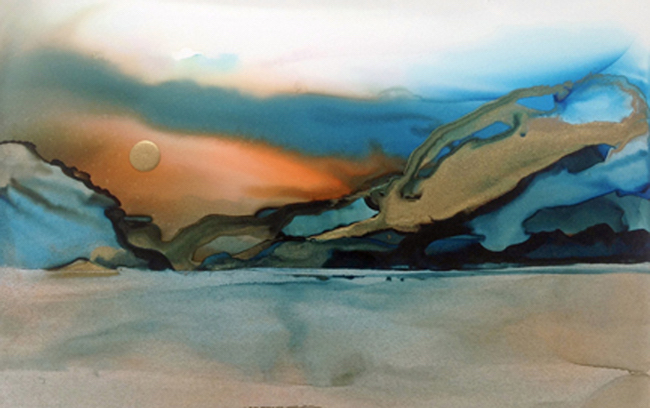Ralph Blakelock. Part 1. – my daily art display
[ad_1]
A blog I wrote some eleven years ago featured an artist who spent the last twenty years of his life in an asylum. He was Richard Dadd, the English Victorian painter. Today I am looking at the life and works of an American painter, Ralph Albert Blakelock, a contemporary of Dadd, who was also incarcerated in an asylum during the last eighteen years of his life.

The art of Ralph Albert Blakelock is termed as being of the Romanticism movement. The Romantic movement, which emphasized emotion and imagination, emerged in response to the artistic disenchantment with the Enlightenment ideas of order and reason. Blakelock was a painter known mainly for his landscape paintings related to the Tonalism movement. Tonalism is, at times, used to describe American landscapes derived from the French Barbizon style, which accentuated mood and shadow.

Ralph Blakelock was born on Christopher Street in New York City on October 15th, 1847. He was the son of Ralph Albert and Caroline Blakelock. His father was an English immigrant carpenter, who would later serve as a police officer before becoming a homeopathic doctor. It was not Ralph’s father but his uncle James A. Johnson, a choirmaster who was to be Ralph’s cultural mentor. Ralph had connections with art through his uncle’s friendship with the great American landscape painters of the time, Frederic Church with and James Renwick Brevoort. Ralph had four brothers and four sisters. His father had hoped that Ralph would follow in his footsteps and study medicine and so it transpired that in 1864, seventeen-year-old Ralph began to study medicine at the Free Academy of New York. However he gave up his studies at the academy after he had completed the third semester.

Blakelock ended his further education in 1866 and began to study art and paint landscapes full-time. To look for different landscapes to paint he made several sketching trips in upstate New York and New Hampshire. One of his first exhibition pieces was exhibited at the National Academy of Design in 1868, when he exhibited a view of the White Mountains.

The voyage of discovery for Blakelock proved to be central to his artistic vision and was to be an influence on his work for the rest of his life. Such cross-country trips had become popular with artists such as Albert Bierstadt and Thomas Moran but their journeys were part of expeditions funded by the US government, unlike the one Blakelock undertook on his one-man adventure. He wanted to “go West” and explore more of his country and whilst doing so, sketch and paint what he saw.

In 1869, thanks to his father’s financial backing, Blakelock began the first of two lengthy journeys to the western territories of the United States. His extensive travelling was done using the train, stagecoach, and horseback, and his trip took him to the states of Kansas, Colorado, Wyoming, Utah, and Nevada, finally arriving on the west coast and California. After spending time in that state, he travelled south into Mexico. It is thought that he arrived back home by sea in 1871. The voyage of discovery for Blakelock proved to be central to his artistic vision and was to be an influence on his work for the rest of his life.

A year later, in 1872, Blakelock embarked on a second western trip. Blakelock spent all his time sketching and painting and it was during this voyage of discovery that he became interested in one of his most lasting subjects for his work – the Native Americans. He painted tableaux of American Indian dancers, tented encampments and native Indian horseback riders Like artists who had journeyed west, there is no doubt that Blakelock was impressed by the vastness of the landscape. He spent time with various American Indian tribes and would often travel alone into the wilderness on horseback and spent time with tribes of the Great Sioux Nation. It was a time when the Native Americans were still retaining many of their traditional practices despite the constant incursion on their lands by the white Americans from the East who were expanding rapidly taking hold of the land belonging to the Native Indians. Blakelock liked to depict Indian encampments in his paintings. His paintings were not just about pretty scenes, they were a pictorial history of the time. Mark Mitchell, the American writer and the Holcombe T. Green Curator of American Paintings and Sculpture at the Yale University Art Gallery, wrote in his 2008 article Radical Color: Blakelock in Context about Blakelock’s work during his travels West: He wrote:
“…they were documents of his experience and observations, but with time they became documents of his memory, as well as the memory of the nation at large…”
Once Blakelock returned to New York after his wanderings in the West he rented his own studio and exhibited his work at the National Academy as well as the Society of American Artists and the Brooklyn Art Association. Initially his paintings followed the Hudson River School style

Now back on the East Coast, Blakelock began to concentrate on depictions of the northern edges of the outer city (what is now 55th Street and Central Park), which had yet to be developed. Here he focused on the shanties which were starting to appear. One such painting was his 1874 work entitled Shanties in Harlem.

In 1877, Blakelock married Cora Rebecca Bailey and, soon after, the first of their nine children, Carl, was born. It was probably at this time in Blakelock’s life that things started to go wrong. Unfortunately for Blakelock the art critics did not look upon his work favourably and the public were reluctant to buy his paintings at the advertised price. Coming into play was the dreaded balance of matching income with expenditure. His income was decreasing as he was having to sell his work cheaply. However, the increasing size of his family had to be housed and fed. He had to increase his rate of production of his paintings to boost his income. In his book, The Unknown Night: The Madness and Genius of R. A. Blakelock, An American Painter, Glyn Vincent tells that Blakelock’s wife, Cora, in a letter to the art dealer, Robert Vose, who ran the Vose Gallery in Boston, wrote that her husband did just that. She wrote:
“…His best work took a long time to complete and in the meantime he had to live. Pictures were painted to keep things going. He could paint a really good picture in less time than anyone else I ever saw…”
In 1880, his second child, Marian is born and in 1883, Blakelock moved into the prestigious Tenth Street Studio Building, in New York and had famous neighbours such as William Merritt Chase and Frederic Church. He took part in the 1884 Society of American Artists exhibition and this boosted his reputation with his work being hailed by the press as being among the best works on show. Clarence Cook of the Tribune wrote:
“…it was the best work of his which we have seen, marked not only by rich coloring, but by the possession of a distinctive character…”
The year 1884 was the year of the birth of his third and fourth chiId, twins, Claire and Ralph and so it became a dire financial struggle and to support his new and rapidly growing family. Blakelock would sometimes take jobs as an art teacher and later would produce small paintings of birds, flowers, and landscapes on plaques at E. C. Meekers Art Novelty Shop in New Jersey while he and his family lived nearby in East Orange.

Despite the good press reviews of his work, Blakelock was still struggling financially. One reason could be that to avoid paying dealers a commission for selling his work he sold his own paintings and although he saved money, he lost the power of marketing and advertising a dealer would have afforded him. In 1886, the popular journal, Harper’s Weekly, reviewing an exhibition at the National Academy of Design praised Blakelock’s painting entitled A Waterfall, Moonlight hailing it as the best landscape in the exhibition, and the art critic admitted that he was surprised to see the name of the artist having completed such a powerful landscape. The painting featured elements that are typical of Blakelock’s style, such as generalized and silhouetted forms, glowing moonlight, and thick paint. The foliage that frames the edge of the canvas echoes the irregular contours of the tree so much that it gives the impression that the forms are almost able to interlock.

The year 1886 was also the year of the birth of Ralph’s fifth child, Mary, and, tragically, the year of the death of one of his twins, his two-year-old daughter Claire. In 1887 his sixth child, Louis was born. The financial stress on Blakelock continued to mount and cause him mental stress until March 1890, when it culminated in his first mental breakdown and he was taken by his brother to the Flatbush Insane Asylum.

Blakelock stayed in the asylum for a short time and on his release, a wealthy patron of his, the English-born textile firm owner, Catholina Lambert allowed Blakelock, his wife Cora, and their four children to come to his estate in Hawley, Pennsylvania, to convalesce. Having recuperated, he returned to New York, where Blakelock began working out of fellow artists’ studios and later president of the National Academy of Design, Harry Watrous’s studio in the Sherwood Building. This building was at 58 West 57th Street, at the southeast corner with Sixth Avenue (Avenue of the Americas) in Midtown Manhattan, New York City. The building was constructed in 1879 as artists’ apartments. It was here that Blakelock painted his masterpiece Brook by Moonlight which is now part of the Toledo Museum of Art collection. Depicting moonlight, sunsets, and twilight were favourite depictions of Blakelock It is said that they held a special attraction for Ralph Albert Blakelock for their poetic qualities and in this work he expressed his personal response to nature in this mysterious and haunting moonlit forest.
Sadly the life of Ralph Blakelock was going to take a turn for the worse…..
…….to be continued.
[ad_2]
Source link









